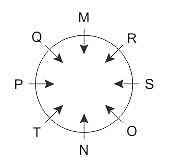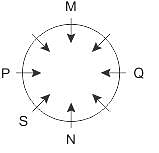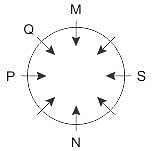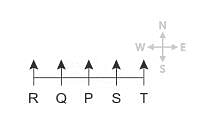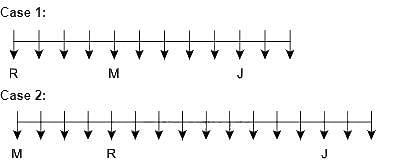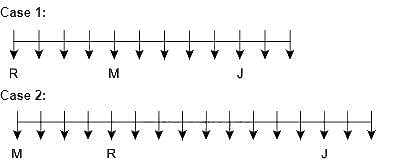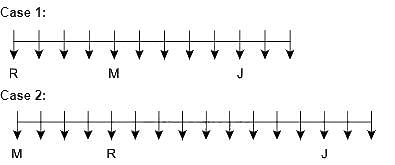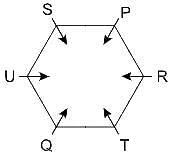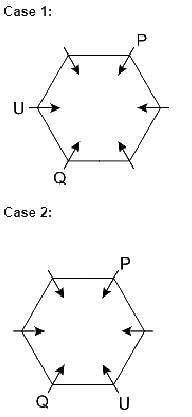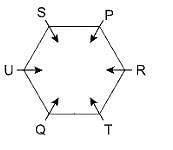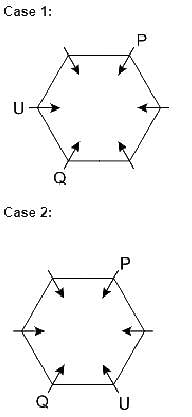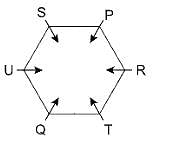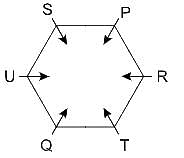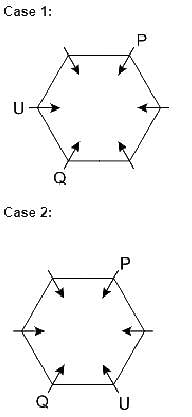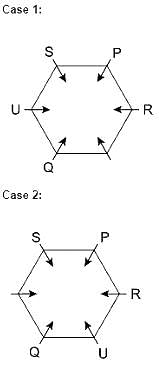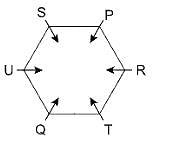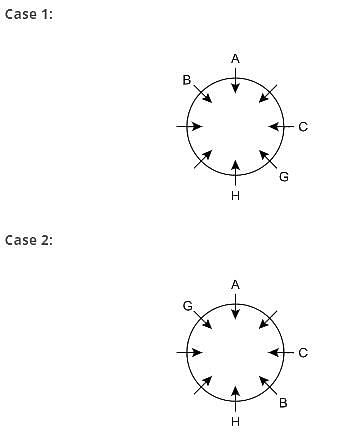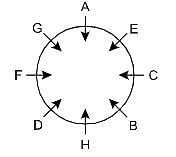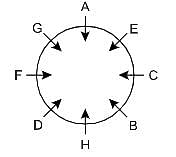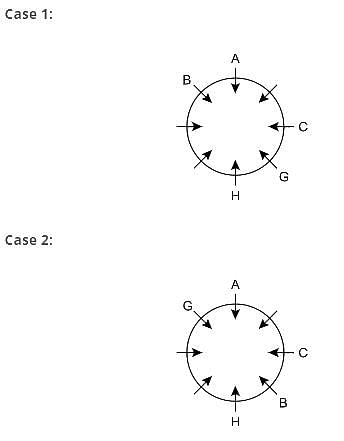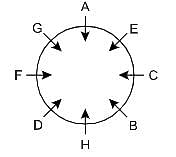MCQ: Seating Arrangements- 2 - SSC CGL MCQ
15 Questions MCQ Test SSC CGL Tier 2 - Study Material, Online Tests, Previous Year - MCQ: Seating Arrangements- 2
Direction: Study the following information carefully and answer the given questions besides.
M, N, O, P, Q, R, S and T are sitting around a circular table and all are facing the centre of the table. M is sitting fourth to the right of N. P is sitting second to the left of N. Q is sitting third to the right of S. T is sitting second to the left of O. S is not sitting beside P. O is not sitting beside M.
Q. Who among the following sits exactly opposite to Q?
Q. Who among the following sits exactly opposite to Q?
Direction: Study the following information carefully and answer the given questions besides.
M, N, O, P, Q, R, S and T are sitting around a circular table and all are facing the centre of the table. M is sitting fourth to the right of N. P is sitting second to the left of N. Q is sitting third to the right of S. T is sitting second to the left of O. S is not sitting beside P. O is not sitting beside M.
Q. Who among the following is the immediate neighbour of P and M?
Q. Who among the following is the immediate neighbour of P and M?
| 1 Crore+ students have signed up on EduRev. Have you? Download the App |
Direction: Study the following information carefully and answer the given questions besides.
Five students participated in a math test. Tarun scored more marks than Priyam but less than Rahul. Sagar neither scored 3rd highest nor scored lowest marks. Priyam scored more marks than Anurag. Sagar scored less marks than Tarun, who scored 87 marks.
Q. Who scored 2nd lowest marks?
Q. Who scored 2nd lowest marks?
Direction: Study the following information carefully and answer the given questions besides.
Five students participated in a math test. Tarun scored more marks than Priyam but less than Rahul. Sagar neither scored 3rd highest nor scored lowest marks. Priyam scored more marks than Anurag. Sagar scored less marks than Tarun, who scored 87 marks.
Q. How many marks Rahul could have scored?
P, Q, R, S and T are sitting in a straight line facing the North. P sits next to S but not to T. Q is sitting next to R, who sits on the extreme left corner. Who sits to the immediate left of S if T does not sit next to Q?
Direction: Study the following information carefully and answer the given questions besides.
Some boys are sitting in a row facing the south. Only three boys sit between O and H. Only two boys sit to the left of J. O sits third to the left of M. More than seven boys sit between P and J. V sits fourth to the right of O. Eight boys sit between R and J. More than 12 boys sit between P and H. Only three boys sit between R and M. T sits third to the right of M. P sits fourth to the right of R.
Q. At least how many boys are sitting in a row?
Direction: Study the following information carefully and answer the given questions besides.
Some boys are sitting in a row facing the south. Only three boys sit between O and H. Only two boys sit to the left of J. O sits third to the left of M. More than seven boys sit between P and J. V sits fourth to the right of O. Eight boys sit between R and J. More than 12 boys sit between P and H. Only three boys sit between R and M. T sits third to the right of M. P sits fourth to the right of R.
Q. How many boys are sitting between T and J?
Direction: Study the following information carefully and answer the given questions besides.
Some boys are sitting in a row facing the south. Only three boys sit between O and H. Only two boys sit to the left of J. O sits third to the left of M. More than seven boys sit between P and J. V sits fourth to the right of O. Eight boys sit between R and J. More than 12 boys sit between P and H. Only three boys sit between R and M. T sits third to the right of M. P sits fourth to the right of R.
Q. Who among the following sits 3rd to the right of the one who sits immediate right of M?
Direction: Study the following information carefully and answer the given questions besides.
Some boys are sitting in a row facing the south. Only three boys sit between O and H. Only two boys sit to the left of J. O sits third to the left of M. More than seven boys sit between P and J. V sits fourth to the right of O. Eight boys sit between R and J. More than 12 boys sit between P and H. Only three boys sit between R and M. T sits third to the right of M. P sits fourth to the right of R.
Q. If 16 boys are sitting in a row, then which pair sits at the extreme ends of the row?
Direction: Study the following information carefully and answer the given questions besides.
Six people P, Q, R, S, T and U are sitting at different corners of a hexagonal table, all facing the centre of the table. Only one person is sitting between P and U. S is sitting second to the right of R. T is not sitting beside S. Exactly two persons are sitting between P and Q.
Q. Which of the following person sits immediate right of Q?
Direction: Study the following information carefully and answer the given questions besides.
Six people P, Q, R, S, T and U are sitting at different corners of a hexagonal table, all facing the centre of the table. Only one person is sitting between P and U. S is sitting second to the right of R. T is not sitting beside S. Exactly two persons are sitting between P and Q.
Q. Who among the following sits exactly opposite to U?
Direction: Study the following information carefully and answer the given questions besides.
Six people P, Q, R, S, T and U are sitting at different corners of a hexagonal table, all facing the centre of the table. Only one person is sitting between P and U. S is sitting second to the right of R. T is not sitting beside S. Exactly two persons are sitting between P and Q.
Q. Who among the following is the immediate neighbour of P and U?
Direction: Study the following information carefully and answer the given questions besides.
Eight person A, B, C, D, E, F, G and H sit around the circular table facing towards the centre but not necessarily in the same order.
G sits opposite to B. One person sits between A and C, who sits second to the right of H. Both G and B do not sit immediate left of H. D sits second to the left of B. A doesn’t sit beside D. E doesn’t face C.
What is the position of G with respect to C?
Direction: Study the following information carefully and answer the given questions besides.
Eight person A, B, C, D, E, F, G and H sit around the circular table facing towards the centre but not necessarily in the same order.
G sits opposite to B. One person sits between A and C, who sits second to the right of H. Both G and B do not sit immediate left of H. D sits second to the left of B. A doesn’t sit beside D. E doesn’t face C.
Q. Who sits opposite to F?
Direction: Study the following information carefully and answer the given questions besides.
Eight person A, B, C, D, E, F, G and H sit around the circular table facing towards the centre but not necessarily in the same order.
G sits opposite to B. One person sits between A and C, who sits second to the right of H. Both G and B do not sit immediate left of H. D sits second to the left of B. A doesn’t sit beside D. E doesn’t face C.
Q. Who among the following sits 3rd to the left of the one who sits opposite to D?
|
1365 videos|1312 docs|1010 tests
|
|
1365 videos|1312 docs|1010 tests
|


